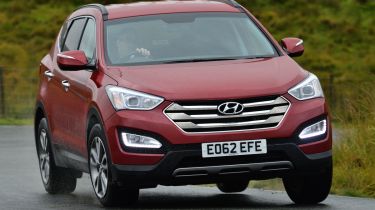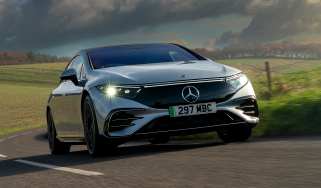Hyundai Santa Fe (2012-2018)
The Santa Fe SUV is classy, but has it made the jump to real premium quality?
Generous standard kit, comfort and low running costs seal victory for the new Santa Fe in this test, although it’s not without its flaws. The rearmost seats are cramped, and for us it doesn’t quite have enough of a premium feel to justify its price tag.
When the second-generation Hyundai Santa Fe arrived in 2006, it was a breath of fresh air. Gone was the MkI’s lumpy bodywork, in favour of a smoother look.
For the new car, Hyundai has brought in sharp lines and angular headlights that echo those of the i30 hatch. Plus, there’s now a distinctive up-kick to the window line and a bold chrome-effect grille. Overall, the new Santa Fe is smart – it definitely looks more modern than its rivals here. But it’s all a bit derivative: that nose is similar to the new Honda CR-V’s, while the rounded tail has a hint of Audi Q5 about it.
Inside, the dashboard has an angular design similar to the i30’s. There are lots of soft-touch plastics and everything feels well built, although our car suffered from a couple of niggles. The switch for the electric parking brake had a tendency to jam in the pulled-up position, while the plastic footrest next to the clutch pedal was a little loose, too.
Used - available now

2023 Hyundai
Santa FE
54,091 milesAutomaticPetrol1.6L
Cash £25,879
2023 Hyundai
Santa FE
30,239 milesAutomaticPetrol1.6L
Cash £26,197
2023 Hyundai
Santa FE
18,718 milesAutomaticPetrol1.6L
Cash £29,227
2023 Hyundai
Santa FE
20,858 milesAutomaticPetrol1.6L
Cash £26,500Still, there’s plenty of space in the front and middle rows. It’s easy to get comfortable at the wheel, as the steering adjusts for reach and height, while the seat is height-adjustable, too, giving you a commanding view of the road. One minor irritation is poor visibility over the shoulder, due to that rising window line, but the standard reversing sensors and camera mean it isn’t much of an issue when parking.
In the third row, space is a disappointment. The new Santa Fe is longer and wider than the car it replaces, but the seats in the boot are still only really suitable for kids. What’s more, the tiny rear windows and low seating position will make them feel very claustrophobic, and the tailgate closes perilously close to your head. Both rivals are better suited to seven-seat use.
There’s decent room for luggage when they’re folded. The middle row has a 40:60 split, while the centre seatback also folds to form an armrest. The seats slide back and forth, and can be reclined as well, while the seats fold completely flat with the pull of a lever in the side of the boot. But the Volvo has the Hyundai beaten for outright space, with a maximum of 1,837 litres, compared with the new car’s 1,615-litre capacity.
On the road, the Santa Fe is a mixed bag. The soft suspension is designed for comfort and soaks up shocks easily. However, if you hit a series of bumps at the right frequency, it will bob and pitch on its suspension, giving a very choppy ride. Take it easy on the motorway, though, and it’s relaxing, with next to no engine noise in the cabin.
In corners there’s lots of body roll, and not as much grip as you’ll find in the XC90. However, even in hard cornering, the standard stability control doesn’t intervene, meaning the Santa Fe feels safe and secure.
Hyundai has fitted its FlexSteer steering system to the Santa Fe, but unlike in the i30, the difference between the three modes is obvious as soon as you turn the wheel. Sport mode adds weight to the steering – although it’s still lighter than the heavy Volvo’s – but Comfort mode makes the wheel over-assisted and disconcertingly vague. This is only really suitable for low-speed manoeuvres.
At the test track, the Hyundai proved to be faster than its rivals, although that can be put down to our car’s manual gearbox. However, the official figures for the auto version still put the Santa Fe ahead of both of its rivals.
The 2.2-litre diesel has plenty of pulling power, and it picks up readily from less than 2,000rpm without having to change down.
The Hyundai’s biggest trump card over the XC90 is its standard kit list. The Santa Fe costs £30,195, so is more than £5,000 cheaper than the Volvo, but it comes with equipment such as Bluetooth and heated seats – these alone add nearly £500 to the Volvo’s list price. Sat-nav, leather trim and a reversing camera are all included on the Santa Fe, too – these aren’t even available on the XC90. In fact, the only options offered on the Hyundai are metallic paint and brown leather. The Captiva matches it for kit, but it costs £2,000 more.
As for other costs, the Hyundai is cheaper to fuel, insure and tax and, while depreciation is greater than the XC90’s, you won’t lose as much cash, thanks to its lower list price.
So, has Hyundai broken new ground and joined the premium SUV elite?



